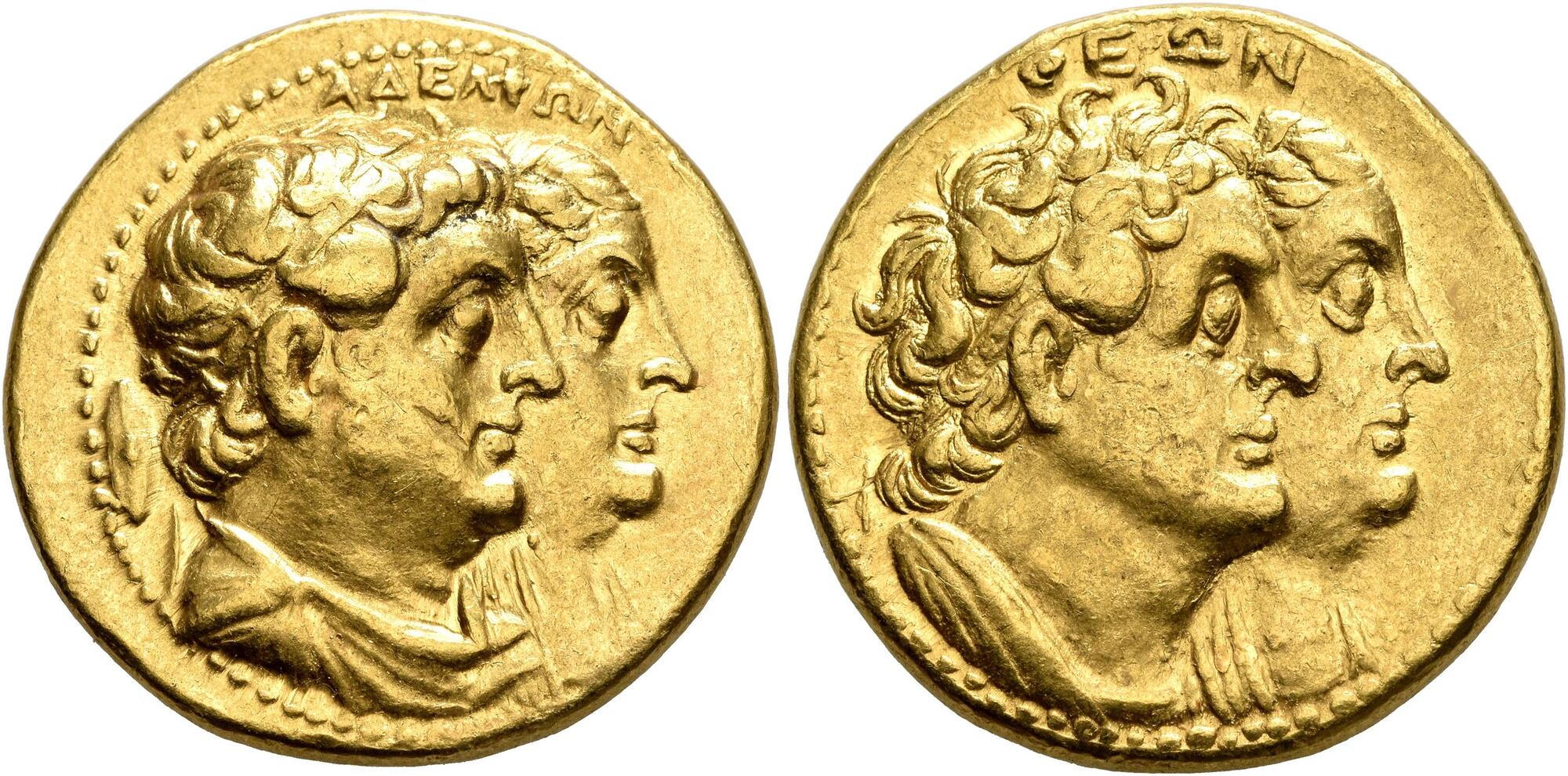S 2061 - Alexandria (Ptolemy II), gold, mnaieia (272-260 BCE)
From SILVER
272 BCE - 260 BCE Gold 121,160 kg
Description
| ObverseInscription or printing placed on the obverse.: | AΔEΛΦΩN (Greek).Conjoined busts of Ptolemy II, diademed and draped, and Arsinöe II, diademed and veiled, to right, behind, Galatian shield |
| ReverseInscription or printing placed on the reverse.: | ΘEΩN (Greek).Conjoined busts of Ptolemy I, diademed and draped, and Berenike, diademed and veiled, to right |
Mint and issuing power
| MintIdentifies the place of manufacture or issue of a numismatic object.: | Alexandria | Ancient regionAncient region.: | Egypt | Modern countryModern country: Egypt | AuthorityIdentifies the issuing power. The authority can be "pretended" when the name or the portrait of X is on the coin but he/she was not the issuing power. It can also be "uncertain" when there is no mention of X on the coin but he/she was the issuing power according to the historical sources: | Ptolemaic dynasty (323-30 BC), Ptolemy II Philadelphus (Ptolemaic king, 283-246 BC) |
Chronology
| FromIdentifies the initial date in a range assigned in a numismatic context. | 272 BCE | toIdentifies the final date in a range assigned in a numismatic context.. | 260 BCE | PeriodTime period of the numismatic object.: Hellenistic 323-30 BC |
Physical description
| MetalThe physical material (usually metal) from which an object is made.: | Gold |
Median weightMedian of the weights of numismatic objects (in grams). in grams | 27.70 | DenominationTerm indicating the value of a numismatic object. Examples: tetradrachm, chalkous, denarius.: | mnaieion |
StandardStandard.: | Ptolemaic |
Image

S2061 Egypt mnaieia Theon Adelphon.jpg [1]
References
| Die study referencePublication of the study: | Olivier - Lorber 20131Olivier - Lorber 2013, p. 65-70, n° 1-164 | ||
| Coin series referenceReference to coin series study: | |||
Obverse dies distribution
| FrequencyFrequency of specimen in distribution. ᵖ | Number of obversesNumber of obverse dies. ᵖ (o) | % (o) | Number of coinsNumber of coins. (n) | % (n) | Die nameName(s) of the die(s). |
| 2 | 3 | 14.29 | 6 | 3.68 | 6, 17, 20 |
| 3 | 2 | 9.52 | 6 | 3.68 | 5, 13 |
| 4 | 1 | 4.76 | 4 | 2.45 | 19 |
| 5 | 2 | 9.52 | 10 | 6.13 | 1, 15 |
| 6 | 2 | 9.52 | 12 | 7.36 | 11, 16 |
| 7 | 1 | 4.76 | 7 | 4.29 | 9 |
| 8 | 4 | 19.05 | 32 | 19.63 | 2, 4, 18, 21 |
| 9 | 1 | 4.76 | 9 | 5.52 | 3 |
| 10 | 1 | 4.76 | 10 | 6.13 | 14 |
| 14 | 1 | 4.76 | 14 | 8.59 | 12 |
| 16 | 1 | 4.76 | 16 | 9.82 | 8 |
| 17 | 1 | 4.76 | 17 | 10.43 | 7 |
| 20 | 1 | 4.76 | 20 | 12.27 | 10 |
| Total | 21 of 21 | 99.98 | 163 of 163 | 99.98 |
Reverse dies distribution
no distribution is available
Quantification
| Number of obversesNumber of obverse dies. ᵖ (o) | 21 | Number of singletons (o1)The number of singleton coins. ᵖ | |
| Number of reverse diesNumber of reverse dies. (r) | 77 | Number of coinsNumber of coins. (n) | 163 |
| Coins per obverse dieNumber of coins per obverse die. (n/o) | 7.76 | Coins per reverse dieNumber of coins per reverse die. (n/r) | 2.12 |
| Reverse per obverse ratioRatio of obverse dies divided by reverse dies. (r/o) | 3.67 | Percentage of singletons (o1)number of coins (n) divided by the number of singletons (o1) ᵖ | % |
| Original number of dies (O) (Carter 1983 formula)The estimation of the number of coins according to Carter 1983 ᵖ | 21.87 | Coins struck if 20,000 as average productivity per dieCoins made if the average productivity for obverses (according to Carter) is 20,000. ᵖ | 437,400 |
| Original number of dies (O) (Esty 2011 formula)The estimation of the number of coins according to the singleton formula in Esty 2011 ᵖ (O) | 24.11 | Survival rate if 20,000 as average productivity per dieSurvival rate if average productivity is 20,000. ᵖ | 0.00037 |
| Coverage (o = % of O) (Esty 1984 formula)Esty 1984 - coverage (% of O) ᵖ (o = % of O) | % | Die productivity if survival rate 1/2,000Average productivity if survival rate is 1/2,000. ᵖ | 14,906.26 |
| Weight of silver (in kg) if 20,000 coins per die (O = Carter formula)Carter 1983 * Median weight * 20000 (*10 if gold or electrum) ᵖ | 121,160 kg <br /> 121,160 kg | Die productivity if survival rate 1/5,000Average productivity if survival rate is 1/5,000. ᵖ | 37,265.66 |
Remarks
Most likely one single workstation
References
- ^ Olivier, Julien - Lorber, Catharine C. (2013), "Three gold coinages of third-century Ptolemaic Egypt," Revue belge de Numismatique, 159, p. 49-150.